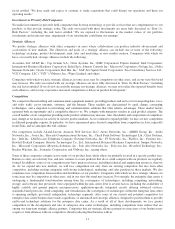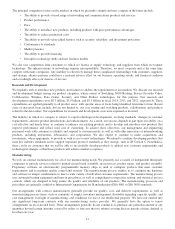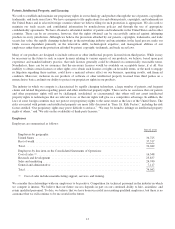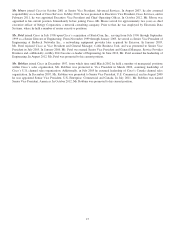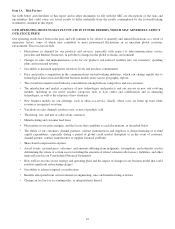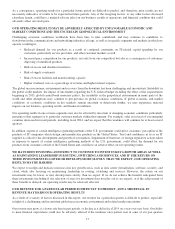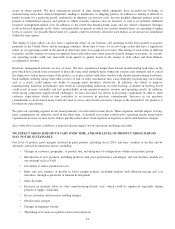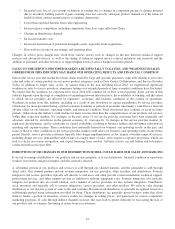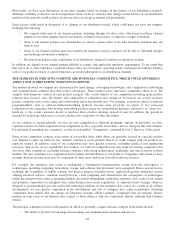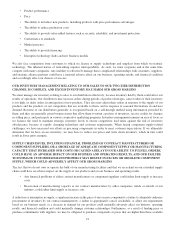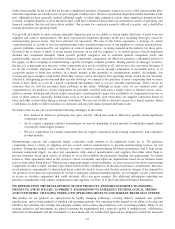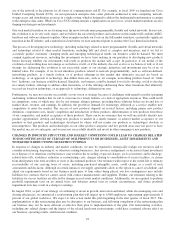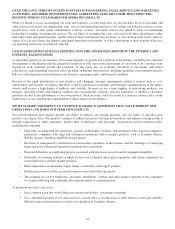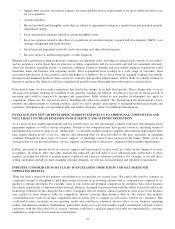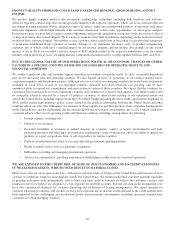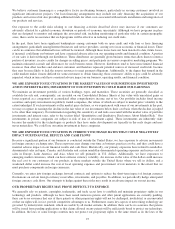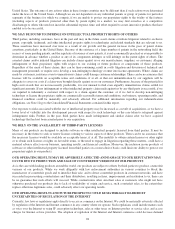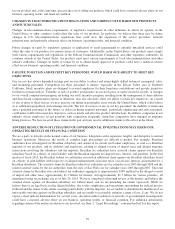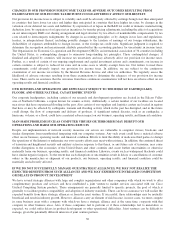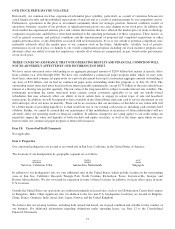Cisco 2014 Annual Report Download - page 29
Download and view the complete annual report
Please find page 29 of the 2014 Cisco annual report below. You can navigate through the pages in the report by either clicking on the pages listed below, or by using the keyword search tool below to find specific information within the annual report.• Product performance
• Price
• The ability to introduce new products, including products with price-performance advantages
• The ability to reduce production costs
• The ability to provide value-added features such as security, reliability, and investment protection
• Conformance to standards
• Market presence
• The ability to provide financing
• Disruptive technology shifts and new business models
We also face competition from customers to which we license or supply technology and suppliers from which we transfer
technology. The inherent nature of networking requires interoperability. As such, we must cooperate and at the same time
compete with many companies. Any inability to effectively manage these complicated relationships with customers, suppliers,
and strategic alliance partners could have a material adverse effect on our business, operating results, and financial condition
and accordingly affect our chances of success.
OUR INVENTORY MANAGEMENT RELATING TO OUR SALES TO OUR TWO-TIER DISTRIBUTION
CHANNEL IS COMPLEX, AND EXCESS INVENTORY MAY HARM OUR GROSS MARGINS
We must manage our inventory relating to sales to our distributors effectively, because inventory held by them could affect our
results of operations. Our distributors may increase orders during periods of product shortages, cancel orders if their inventory
is too high, or delay orders in anticipation of new products. They also may adjust their orders in response to the supply of our
products and the products of our competitors that are available to them, and in response to seasonal fluctuations in end-user
demand. Revenue to our distributors generally is recognized based on a sell-through method using information provided by
them, and they are generally given business terms that allow them to return a portion of inventory, receive credits for changes
in selling price, and participate in various cooperative marketing programs. Inventory management remains an area of focus as
we balance the need to maintain strategic inventory levels to ensure competitive lead times against the risk of inventory
obsolescence because of rapidly changing technology and customer requirements. When facing component supply-related
challenges, we have increased our efforts in procuring components in order to meet customer expectations. If we ultimately
determine that we have excess inventory, we may have to reduce our prices and write down inventory, which in turn could
result in lower gross margins.
SUPPLY CHAIN ISSUES, INCLUDING FINANCIAL PROBLEMS OF CONTRACT MANUFACTURERS OR
COMPONENT SUPPLIERS, OR A SHORTAGE OF ADEQUATE COMPONENT SUPPLY OR MANUFACTURING
CAPACITY THAT INCREASED OUR COSTS OR CAUSED A DELAY IN OUR ABILITY TO FULFILL ORDERS,
COULD HAVE AN ADVERSE IMPACT ON OUR BUSINESS AND OPERATING RESULTS, AND OUR FAILURE
TO ESTIMATE CUSTOMER DEMAND PROPERLY MAY RESULT IN EXCESS OR OBSOLETE COMPONENT
SUPPLY, WHICH COULD ADVERSELY AFFECT OUR GROSS MARGINS
The fact that we do not own or operate the bulk of our manufacturing facilities and that we are reliant on our extended supply
chain could have an adverse impact on the supply of our products and on our business and operating results:
• Any financial problems of either contract manufacturers or component suppliers could either limit supply or increase
costs
• Reservation of manufacturing capacity at our contract manufacturers by other companies, inside or outside of our
industry, could either limit supply or increase costs
A reduction or interruption in supply; a significant increase in the price of one or more components; a failure to adequately authorize
procurement of inventory by our contract manufacturers; a failure to appropriately cancel, reschedule, or adjust our requirements
based on our business needs; or a decrease in demand for our products could materially adversely affect our business, operating
results, and financial condition and could materially damage customer relationships. Furthermore, as a result of binding price or
purchase commitments with suppliers, we may be obligated to purchase components at prices that are higher than those available
21


